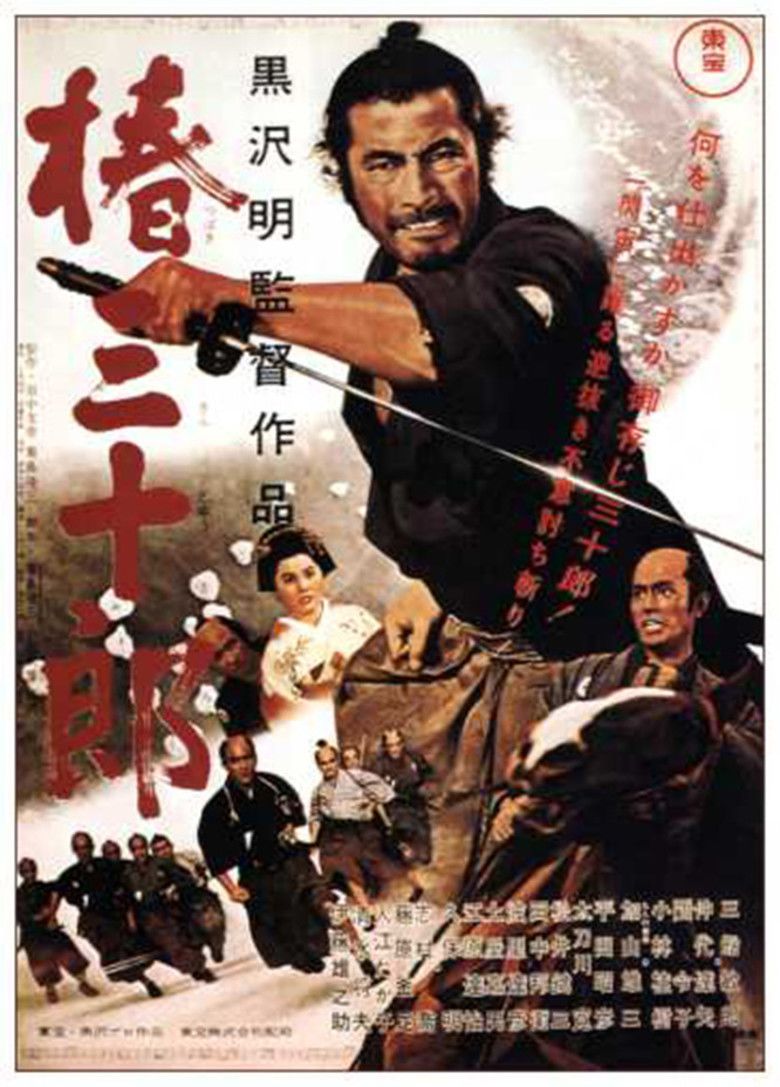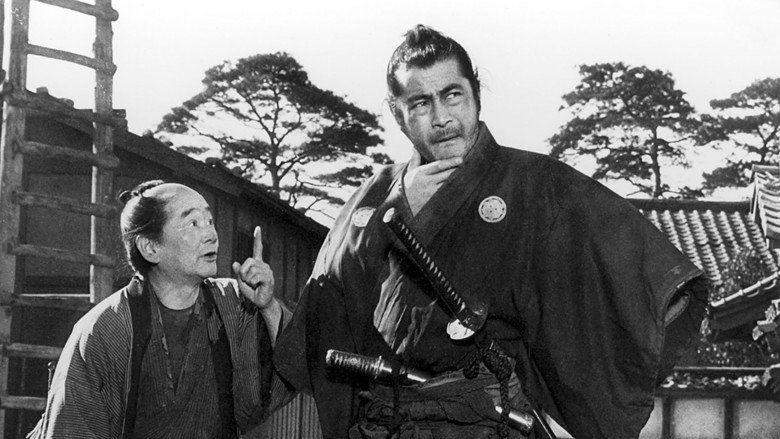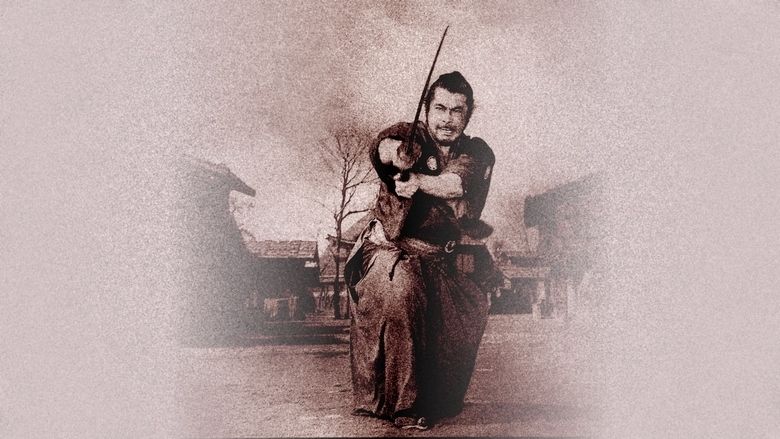Yojimbo (film)
8.4 /10 1 Votes
Director Akira Kurosawa Film series Yojimbo Film Series Country Japan | 8.4/10 IMDb Genre Action, Drama Duration Language Japanese | |||||||||||||||||||||||||||||||||
 | ||||||||||||||||||||||||||||||||||
Release date April 25, 1961 (1961-04-25) Writer Akira Kurosawa (story), Akira Kurosawa (screenplay), Ryuzo Kikushima (screenplay) Screenplay Akira Kurosawa, Ryuzo Kikushima Adaptations A Fistful of Dollars (1964), Sukiyaki Western Django (2007), Inferno (1999) Cast Toshir? Mifune (Sanjuro Kuwabatake / The Samurai), Tatsuya Nakadai (Unosuke, gunfighter), Yôko Tsukasa (Nui), Isuzu Yamada (Orin), Daisuke Katô (Inokichi), Takashi Shimura (Tokuemon, sake brewer)Similar movies The Last Samurai , Samurai Fiction , Zatoichi: The Blind Swordsman , 47 Ronin , Seven Samurai , Rashomon Tagline First class samurai action tale with philosophy to boot | ||||||||||||||||||||||||||||||||||
Yojimbo trailer 1961 the criterion collection
Yojimbo (用心棒, Yōjinbō) is a 1961 jidaigeki film directed by Akira Kurosawa. It tells the story of a rōnin, portrayed by Toshiro Mifune, who arrives in a small town where competing crime lords vie for supremacy. The two bosses each try to hire the newcomer as a bodyguard.
Contents
- Yojimbo trailer 1961 the criterion collection
- Yojimbo trailer 1961 toshir mifune eijir t no tatsuya nakadai english subtitles
- Plot
- Writing
- Casting
- Filming
- Release
- Reception
- Sequel
- Legacy
- References

Based on the success of Yojimbo, Kurosawa's next film, Sanjuro (1962), was altered to incorporate the lead character of this film. In both films, the character wears a rather dilapidated dark kimono bearing the same family mon (likely the emblem of his former samurai clan, before he became a rōnin).

Yojimbo trailer 1961 toshir mifune eijir t no tatsuya nakadai english subtitles
Plot

In 1860, during the final years of the Tokugawa shogunate, a rōnin (masterless samurai) wanders through a desolate Japanese countryside. While stopping at a farmhouse, he overhears an elderly couple lamenting that their only son has given up farm labouring in order to run off and join the rogues who have descended on a nearby town that has become divided by a gang war. The stranger heads to the town where he meets Gonji, the owner of a small izakaya who advises him to leave. He tells the rōnin that the two warring clans are led by Ushitora and Seibei. Ushitora was the right-hand man of Seibei, but rebelled when Seibei decided to hand over the reins to his son Yoichiro, a useless youth. The mayor of town and silk merchant, Tazaemon, had long been in Seibei's pocket, and Ushitora aligned himself with the sake brewer, Tokuemon, proclaiming him the new mayor. After sizing up the situation, the stranger says he intends to stay as the town would be better off with both sides dead.

He first convinces the weaker Seibei to hire him as a swordsman by effortlessly killing three of Ushitora's men. When asked his name, he sees a mulberry field and states his name is 桑畑三十郎 Kuwabatake Sanjuro (桑畑 Kuwabatake = mulberry field). Sanjuro (= thirtieth son) is implied to be a reference to his age, as he slyly quips: "Though I'm closer to forty, actually".
Seibei decides that with the ronin's swordsmanship (a service acquired with a large payment in ryō) the time is right to fight Ushitora. But Sanjuro eavesdrops on Seibei's wife who orders her son to kill him after the upcoming raid so that they will not have to pay his fee. Sanjuro leads his faction to attack the other but then "resigns" leaving Seibei to his fate. But before the two sides clash, the untimely arrival of a bugyō (an Edo Period government official) forces both sides to make a bloodless retreat.
Eventually the bugyō is called away because a government official was murdered in another town. Sanjuro soon learns it was two assassins hired by Ushitora who committed the murder to get the official to leave. With this knowledge, Sanjuro captures the pair of killers and sells them to Seibei. But he then tells Ushitora that it was Seibei's men who caught them. An alarmed Ushitora rewards him for his help. Ushitora then orders the kidnapping of Seibei's son who he offers in exchange for the two prisoners. However, Ushitora double crosses Seibei at the swap when his brother, Unosuke, shoots the assassins with a pistol. But Seibei anticipated this so he kidnapped Ushitora's woman. The next morning she is swapped with Seibei's son.
Sanjuro learns that the woman, Nui, is the wife of a local farmer who lost her to Ushitora over a gambling debt, who then gave her away as chattel to the influential sake brewer, Tokuemon in order to gain his support. Sanjuro tricks Ushitora into revealing the place where Nui is hidden, then kills the guards and reunites the woman with her husband and son and tells them to leave town immediately. Pretending to be on Ushitora's side, Sanjuro is able to convince Ushitora that the woman was kidnapped by Seibei's men. A new spike in violence occurs in the gang war, Tazaemon's silk warehouse is burned down by Ushitora, and Tokuemon's sake brewery is trashed by Seibei in retaliation. After some time, Unosuke becomes suspicious of Sanjuro and the circumstances surrounding Nui's escape. Eventually Sanjuro is severely beaten and imprisoned by Ushitora's thugs after Unosuke discovers evidence of his double cross.
But Sanjuro manages to escape when Ushitora decides to eliminate Seibei once and for all. As he is being carried out of town in a coffin by Gonji, the izakaya owner, he witnesses the brutal end to Seibei, his family and his clan. Sanjuro recuperates in a small temple near a cemetery. However, when he learns that the man who helped him has been taken by Ushitora, he returns to the town. Sanjuro manages to kill Ushitora and his men as well as Unosuke, even though he was armed with a pistol. He only spares one terrified young man who he encountered on his way into town. As Sanjuro surveys the damage, Tazaemon comes out of his home, in samurai outfit and beating a prayer drum. Tazaemon circles around town and then goes after and kills Tokuemon. Sanjuro frees Gonji and then departs knowing that his task has been accomplished.
Writing
Kurosawa stated that a major source for the plot was the 1942 film noir classic The Glass Key, an adaptation of Dashiell Hammett's 1931 novel The Glass Key. It has been noted that the overall plot of Yojimbo is closer to that of another Hammett novel, Red Harvest (1929). Kurosawa scholar David Desser, and film critic Manny Farber claim that Red Harvest was the inspiration for the film; however, Donald Richie and other scholars believe the similarities are coincidental.
When asked his name, the samurai calls himself "Kuwabatake Sanjuro", which he seems to make up while looking at a mulberry field by the town. Thus, the character can be viewed as an early example of the "Man with No Name" (other examples of which appear in a number of earlier novels, including Dashiell Hammett's Red Harvest).
Casting
Many of the actors in Yojimbo worked with Kurosawa before and after, especially Toshiro Mifune, Takashi Shimura and Tatsuya Nakadai.
Filming
After Kurosawa scolded Mifune for arriving late to the set one morning, Mifune made it a point to be ready on set at 6:00 AM every day in full makeup and costume for the rest of the film's shooting schedule.
This was the second film where director Akira Kurosawa worked with cinematographer Kazuo Miyagawa. The sword instruction and choreography for the film were done by Yoshio Sugino of the Tenshin Shōden Katori Shintō-ryū and Ryū Kuze.
Release
Yojimbo was released in Japan on 25 April 1961. The film was released by Seneca International in both a subtitled and dubbed format in the United States on September 1961.
Reception
Yojimbo ranked at #95 in Empire magazine's list of the 500 Greatest Films of All Time. A 1968 screening in the planned community of Columbia, Maryland was considered too violent for viewers causing the hosts to hide in the bathroom to avoid the audience. The film was nominated for the Academy Award for Best Costume Design at the 34th Academy Awards.
Sequel
In 1962, Kurosawa directed Sanjuro, in which Mifune returns as the ronin Sanjuro, but takes a different "surname". In both films, he takes his surname from the plants he happens to be looking at when asked his name.
Legacy
Both in Japan and the West, Yojimbo has had a considerable influence on various forms of entertainment.
In 1964, Yojimbo was remade as A Fistful of Dollars, a Spaghetti Western directed by Sergio Leone and starring Clint Eastwood in his first appearance as the Man with No Name. Leone and his production company failed to secure the remake rights to Kurosawa's film, resulting in a lawsuit that delayed Fistful's release in North America for three years. It would be settled out of court for an undisclosed agreement before the U.S. release. In Yojimbo, the protagonist defeats a man who carries a gun, while he carries only a knife and a sword; in the equivalent scene in Fistful, Eastwood's pistol-wielding character survives being shot by a rifle by hiding an iron plate under his clothes to serve as a shield against bullets.
A second, looser Spaghetti Western adaptation, Django, was directed by Sergio Corbucci in 1966 and featured Franco Nero in the title role. Known for its high level (at the time of its release) of graphic violence, the film's character and title were referenced in over thirty unofficial "sequels".
The 1970 film Zatoichi Meets Yojimbo features Mifune as a somewhat similar character. It is the twentieth of a series of movies featuring the blind swordsman Zatoichi. Although Mifune is clearly not playing the same man as he did in the two Kurosawa films (his name is 佐々大作 Sasa Daisaku, and his personality and background are different in many key respects), the movie's title and some of its content do intend to suggest the image of the two iconic jidaigeki characters confronting each other.
Incident at Blood Pass, also made in 1970, also stars Mifune in a role even more similar to that of Sanjuro. Although never spoken aloud in the film, the character's name is 鎬刀三郎 Shinogi Tosaburō. As was the case with Sanjuro, this character's surname of 鎬 Shinogi is not an actual proper family name, but rather a term that means "ridges on a blade".
Mifune's character became the model for John Belushi's Samurai Futaba character on Saturday Night Live.
In The Warrior and the Sorceress (1984), the mercenary warrior Kain (David Carradine) sets rival warlords Zeg and Balcaz against each other in a battle over a town's only well. The action is set on Ura, a desert planet with two suns.
Last Man Standing (1996) is a Prohibition-era gangster thriller directed by Walter Hill and starring Bruce Willis. Both Kikushima and Kurosawa are specifically listed in this movie's credits as having provided the original story.
At the closing of Episode XXIII of the animated series Samurai Jack, a triumphant Jack walks off alone in a scene (and accompanied by music) influenced by the closing scene and music of Yojimbo. In Episode XXVI, Jack confronts a gang who destroyed his sandals, using Clint Eastwood's lines from A Fistful of Dollars, but substituting "footwear" for "mule". The influence of Yojimbo in particular (and Kurosawa films in general) on the animated series has been noted by Matthew Millheiser at DVDtalk.
References
Yojimbo (film) WikipediaYojimbo (film) IMDb Yojimbo (film) themoviedb.org
